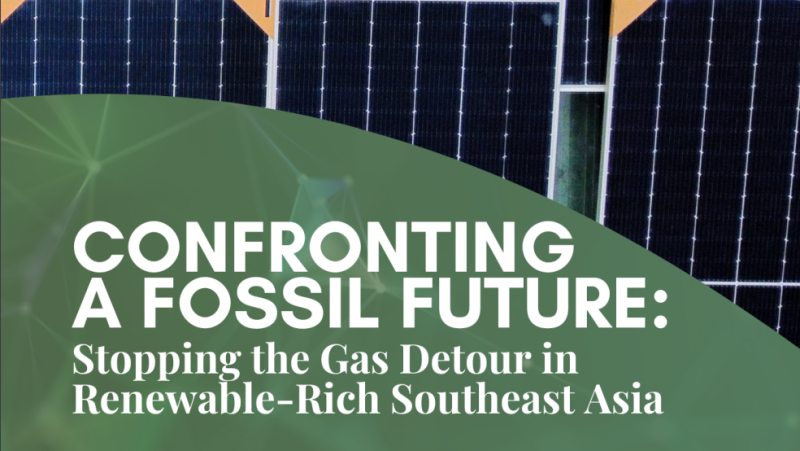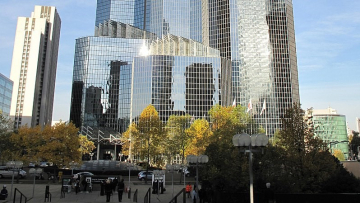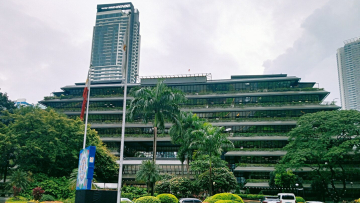Confronting a Fossil Future: Stopping the gas detour in renewable-rich Southeast Asia

Key points:
- Southeast Asia is developing 139 GW of new gas power – over a fourth of all planned gas capacity in Asia.
- Since the Paris Agreement, financial institutions have poured USD 60.3 billion into the gas industry. Renewables received only about half of this amount.
- Southeast Asia is renewable energy rich, with nearly twice as much capacity planned for renewables than gas. Shifting focus to financing and developing renewables is necessary to help avert a more climate-catastrophic future for the region.
As the UN climate talks come in full swing, clean energy think-tank Center for Energy, Ecology, and Development (CEED) and partners made the case for stopping massive plans for gas expansion and hastening the renewable energy shift in Southeast Asia (SEA), as detailed in new research. The report Confronting a Fossil Future delves into the projects and companies of fossil gas, liquified natural gas (LNG), and renewable energy, exploring the institutions involved in their financing and development from 2016 to 2023.
Since 2016, 29 GW of new gas power plant capacity is newly operated across SEA. 139 GW of gas and liquefied natural gas is currently in the pipeline – a capacity that’s the 2nd biggest among Asian subregions, following East Asia. The surge in gas power comes with a boom in new proposed LNG import capacity, reaching 96.3 million MTPA. While it is largely shaping into an LNG import hub, SEA also hosts two biggest global exporters of LNG. In 2022, Malaysia and Indonesia ranked fifth and sixth among countries with the biggest LNG exports, accounting for roughly 10% of the global LNG exports combined. The two countries also make up SEA’s planned new LNG export capacity totaling 13.5 MTPA.
The mad dash for gas makes no sense for a region highly vulnerable to the climate crisis, CEED and partners said, and would not be possible without fossil finance, the groups said, with financial institutions having channeled USD 60.3 billion to the gas industry since 2016. The report raised alarm over the heavy hand of developed countries in the gas build-out: four Japanese banks including Japan Bank for International Cooperation (JBIC), Sumitomo Mitsui, Mizuho Financial Group, and Mitsubishi UFJ with a combined funding of USD 9.7 billion are among the top ten biggest financiers of gas in SEA. Locally, Thai banks provided the biggest support with a total USD 10.2 billion. Of private financial institutions identified to have contributed to the industry since 2016, 36 are signatories of either the Net-Zero Banking Alliance, Net-Zero Asset Owner Alliance, or Net-Zero Asset Managers Initiative, which form part of the larger Glasgow Financial Alliance for Net Zero (GFANZ).
But SEA is also at the cusp of a renewable energy transition, the report says. Since 2016, SEA countries added more renewable energy capacity than gas, even as renewables received only about half as much financing than gas in the same period at USD 31.8 billion. At 328 GW, planned renewable energy capacity in the region also far eclipses that of gas. For the groups, the potential for massive renewable energy deployment in the region – led by countries like Vietnam and the Philippines which also have the biggest plans for new gas capacity – calls for an end to financing and policies that embolden a gas detour in the region.
Civil society representatives give their takes:
Gerry Arances, Executive Director, CEED: “Southeast Asia is at the cusp of a renewable energy transition, but the massive promotion of liquefied natural gas and fossil gas in the region undermines this. Ultimately, it also undermines the hope to keep the 1.5°C goal within reach. This is a matter of life and death for Southeast Asian peoples who are among the most vulnerable in the world to the climate crisis. As COP 28 rolls on, Southeast Asian governments can serve the best interests of their people by demanding for the end of financing for fossil fuels and a swift and just transition to 100% renewable energy. Developed nations, meanwhile, have no business driving Southeast Asia to climate chaos with gas, and must instead focus on delivering their responsibilities to unlock a renewable energy shift in SEA.
Hiroki Osada, Development Finance and Environment Campaigner, Friends of the Earth – Japan: “The report revealed that the Japanese public finance institution, Japan Bank for International Cooperation (JBIC), is accounting for 47% of total public finance to fossil gas in Southeast Asia, making it the biggest financier of fossil gas in the region. So despite the Japanese government’s claim that it contributes to decarbonization in Asia, Japan is actively derailing the decarbonization. Japan should support real climate solutions such as solar and wind which meet communities’ needs, instead of harmful fossil gas projects, which destroy livelihood of local community and marine biodiversity, exemplified by the Ilijan LNG terminal in the Philippines. It’s time for Japan to say Sayonara (Good Bye) to fossil gas.”
Sigit Budiono, Research and Campaign Lead, People’s Coalition for The Rights to Water (KRuHA): “Indonesia has been an important fossil gas business player in the region for decades. International corporations and extractive ruling regimes have extracted and used fossil gas in Indonesia on a large scale just to make a profit without looking at the social and ecological impacts it has had on the surrounding community and the world. However, resistance from the communities to this business chain is growing. Fisherfolks communities, peasants, indigenous and customary communities, and other communities are increasingly aware that the impact of the fossil gas business on the environment and the future of their livelihoods must be stopped.”
Katrin Ganswindt, Head of Fossil Finance Research, urgewald: “Financing new fossil gas plants is not supporting the energy transition, but instead an investment in stranded assets. To leapfrog from coal to clean, energy companies in the Philippines need to invest massively in renewable energy solutions. Banks and regulators should make it cheap and easy for them to finance the renewable build-out.”
Tzeporah Berman, Chair, Fossil Fuel Non-Proliferation Treaty: “To align to the 1.5°C goal means no new exploration and no new financing of all fossil fuel projects, including gas – not just in SEA but anywhere in the world. The fact that we have investments that you see in this report being done in SEA and being pushed and financed by countries like Japan while they are here talking about meeting our climate targets is absolutely absurd…People have talked about gas as a bridge, that gas is a transition. But we see in this report that it is blocking investment in renewables. Gas is no longer if it ever was a transition. It’s not a bridge. It’s a blockade to the clean and safer future that we need.”


